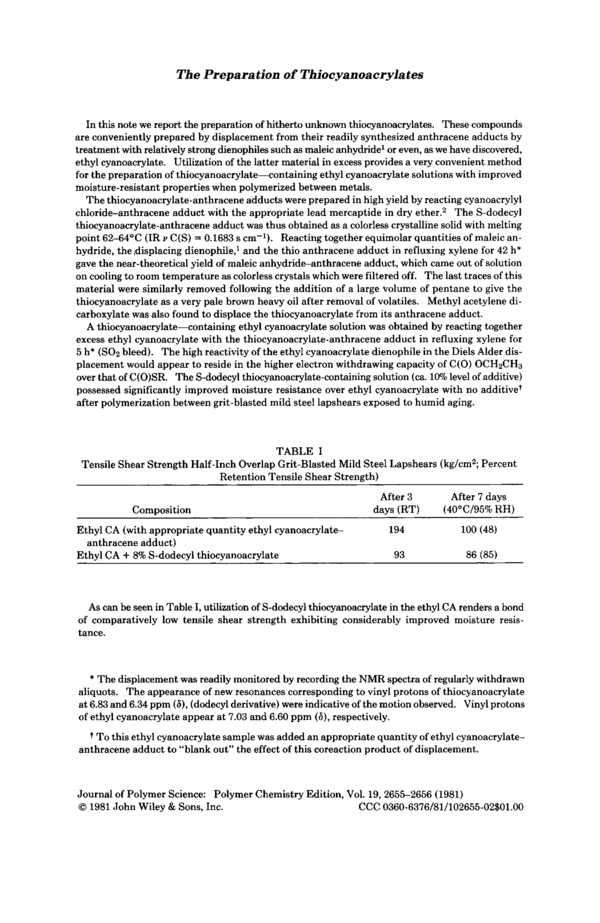The Preparation of Thiocyanoacrylates
The Preparation of Thiocyanoacrylates
Folder:
Journal:
Year:
DOI:
10.1002/pol.1981.170191025
Type of document:
Language:
The Preparation of Thiocyanoacrylates
In this note we report the preparation of hitherto unknown thiocyanoacrylates. These compounds
are conveniently prepared by displacement from their readily synthesized anthracene adducts by
treatment with relatively strong dienophilessuch as maleic anhydride’ or even, as we have discovered,
ethyl cyanoacrylate. Utilization of the latter material in excess provides a very convenient method
for the preparation of thiocyanoacrylate-containing ethyl cyanoacrylate solutions with improved
moisture-resistant properties when polymerized between metals.
The thiocyanoacrylate-anthraceneadducts were prepared in high yield by reacting cyanoacrylyl
chloride-anthracene adduct with the appropriate lead mercaptide in dry ether.2 The S-dodecyl
thiocyanoacrylate-anthracene
adduct was thus obtained as a colorless crystalline solid with melting
point 62-64°C (IR v C(S) = 0.1683 s cm-’). Reacting together equimolar quantities of maleic anhydride, the ,displacing dienophile,’ and the thio anthracene adduct in refluxing xylene for 42 h*
gave the near-theoretical yield of maleic anhydride-anthracene adduct, which came out of solution
on cooling to room temperature as colorless crystals which were filtered off. The last traces of this
material were similarly removed following the addition of a large volume of pentane to give the
thiocyanoacrylate as a very pale brown heavy oil after removal of volatiles. Methyl acetylene dicarboxylate was also found to displace the thiocyanoacrylate from its anthracene adduct.
A thiocyanoacrylate-containing ethyl cyanoacrylate solution was obtained by reacting together
excess ethyl cyanoacrylate with the thiocyanoacrylate-anthraceneadduct in refluxing xylene for
5 h* (SO2 bleed). The high reactivity of the ethyl cyanoacrylate dienophile in the Diels Alder displacement would appear to reside in the higher electron withdrawing capacity of C(0) OCHzCH3
f
solution (ca. 10%level of additive)
over that o C(0)SR. The S-dodecylthiocyanoacrylate-containing
possessed significantly improved moisture resistance over ethyl cyanoacrylate with no additive’
after polymerization between grit-blasted mild steel lapshears exposed to humid aging.
TABLE I
Tensile Shear Strength Half-Inch Overlap Grit-Blasted Mild Steel Lapshears (kg/cm2;Percent
Retention Tensile Shear Strength)
Composition
Ethyl CA (with appropriate quantity ethyl cyanoacrylateanthracene adduct)
Ethyl CA 8% S-dodecyl thiocyanoacrylate
+
After 3
days (RT)
After 7 days
(4OoC/95%
RH)
194
100 (48)
93
86 (85)
As can be seen in Table I, utilization of S-dodecylthiocyanoacrylatein the ethyl CA renders a bond
of comparatively low tensile shear strength exhibiting considerably improved moisture resistance.
* The displacement was readily monitored by recording the NMR spectra of regularly withdrawn
aliquots. The appearance of new resonances corresponding to vinyl protons of thiocyanoacrylate
a t 6.83 and 6.34 ppm (a), (dodecyl derivative) were indicative of the motion observed. Vinyl protons
of ethyl cyanoacrylate appear a t 7.03 and 6.60 ppm (a), respectively.
+ To this ethyl cyanoacrylate sample was added an appropriate quantity of ethyl cyanoacrylateanthracene adduct to “blank out” the effect of this coreaction product of displacement.
Journal of Polymer Science: Polymer Chemistry Edition, Vol. 19,2655-2656 (1981)
0 1981 John Wiley & Sons, Inc.
CCC 0360-6376/81/102655-02$01.00
2656
NOTES
References
1. C. J. Buck, US.Patent 4,013,703,1977.
2. G. Braude, J. Org. Chern., 22,1675 (1957).
S. HARRIS
Research & Development
Loctite Ltd.
Dublin, Ireland
Received March 4,1981
Accepted May 15,1981
Coments go here:
- Log in to post comments

